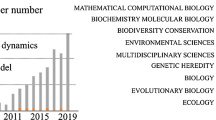Abstract
In this work, we model the time and age evolution of a partially clonal population, i.e., able to reproduce sexually and asexually, in an environment with unlimited resources. The population is divided in two subpopulations, sexual and asexual, whose densities follow a coupled system of McKendrick–Von Foerster equations of evolution. The transition from one subpopulation to another is driven by transition probabilities for newborns to be sexual (resp. asexual) when their parent(s) is(are) in the asexual (sexual) subpopulation. We study the optimization of the growth rate of the whole population, with respect to these transition probabilities. We prove, using a result of the variation of the first eigenvalue (Malthusian growth rate) for this problem, that the maximal eigenvalue is reached when the probabilities are exactly (in time) equal to zero or one. Moreover, depending on birth and death rates of both subpopulations (asexual and sexual), we show that the maximal growth rate is reached when the population newborns switch (completely) from sexual to asexual and then from asexual to sexual (periodically in time) or when a subpopulation disappears.




Similar content being viewed by others
Notes
For aphids around 7 [7].
For the survival (and more precisely the growth) of the asexual population during Spring to Autumn.
References
Williams, G.C.: Sex and Evolution. Princeton University Press, Oxford (1975)
Goodwillie, C., Kalisz, S., Eckert, C.G.: The evolutionary enigma of mixed mating systems in plants: occurrence, theoretical explanations, and empirical evidence. Ann. Rev. Ecol. Evolut. Syst. 36, 47–79 (2005)
Le Trionnaire, G., Hardie, J., Jaubert-Possamai, S., Simon, J.C., Tagu, D.: Shifting from clonal to sexual reproduction in aphids: physiological and developmental aspects. Biol. Cell 100(8), 441–51 (2008)
Rispe, C., Pierre, J.-S., Simon, J.C., Gouyon, P.H.: Models of sexual and asexual coexistence in aphids based on constraints. J. Evolut. Biol. 11(11), 685–701 (2002)
Halkett, F., Harrington, R., Hullé, M., Kindlmann, P., Menu, F., Rispe, C., Plantegenest, M.: Dynamics of production of sexual forms in aphids: theoretical and experimental evidence for adaptive “Coin-Flipping” plasticity. Am. Nat. 163(6), E112–E125 (2004)
Dagg, J.: Strategies of sexual reproduction in aphids, Strategies of Sexual Reproduction in Aphids. PhD thesis, University of Göttingen, Germany (2002)
Sanchez-Palencia, E., Lherminier, P., Francoise, J.P.: A mathematical model for alternation of polygamy and parthenogenesis: stability versus efficiency and analogy with parasitism. Acta Biotheor. 64(4), 537–552 (2016)
Michel, P., Mischler, S., Perthame, B.: General relative entropy inequality: an illustration on growth models. J. Math. Pures Appl. 84(9), 1235–1260 (2005)
Perthame, B.: Transport Equations in Biology. Birkhäuser, Basel (2007)
Michel, P.: Fitness optimization in a cell division model. Comptes Rendus Math. 341(12), 731–736 (2005)
Michel, P.: Optimal proliferation rate in a cell division model. Math. Model. Nat. Phenom. 1(2), 23–44 (2006)
Clairambault, J., Michel, P., Perthame, B.: Circadian rhythm and tumour growth. Comptes Rendus Math. 342(1), 17–22 (2006)
Clairambault, J., Michel, P., Perthame, B.: A mathematical model of the cell cycle and its circadian control. In: Deutsch, A., Brusch, L., Byrne, H., de Vries, G., Herzel, H. (eds.) Mathematical Modeling of Biological Systems, Volume I: Cellular Biophysics, Regulatory Networks, Development, Biomedicine, and Data Analysis, pp. 239–251. Birkhäuser, Boston (2007)
Campillo, F., Champagnat, N., Fritsch, C.: On the variations of the principal eigenvalue with respect to a parameter in growth-fragmentation models. Commun. Math. Sci. 15(7), 1801–1819 (2017)
Olivier, A.: How does variability in cell aging and growth rates influence the Malthus parameter? Kinet. Relat. Models 10(02), 481–512 (2016)
Fisher, R.A.: The Genetical Theory of Natural Selection. Clarendon, Oxford (1930)
Edwards, A.W.F.: Natural selection and the sex ratio: Fisher’s sources. Am. Nat. 151(6), 564–569 (1998)
Hamilton, W.D.: Extraordinary sex ratios. Science 156(3774), 477–488 (1967)
Collier, R.H., Finch, S.: IPM case studies—Brassicas. In: van Emden, H., Harrington, R. (eds.) Aphids as Crop Pests. CABI Publishing, London (2007)
Metz, J.A.J., Diekmann, O. (eds.): The Dynamics of Physiologically Structured Populations. Springer, Berlin (1986)
Cushing, J.M.: Periodic McKendrick equations for age-structured population growth. Comput. Math. Appl. 12(4), 513–526 (1986)
Floquet, G.: Sur les équations différentielles linéaires à coefficients périodiques. Annales de l’École Normale Supérieure 12, 47–88 (1883)
Sonneborn, L., Van Vleck, F.: The Bang–Bang principle for linear control systems. SIAM J. Control 2, 151–159 (1965)
Author information
Authors and Affiliations
Corresponding author
Additional information
Communicated by Alberto d’Onofrio.
Publisher's Note
Springer Nature remains neutral with regard to jurisdictional claims in published maps and institutional affiliations.
Rights and permissions
About this article
Cite this article
Michel, P. Bang–Bang Growth Rate Optimization in a Coupled McKendrick Model. J Optim Theory Appl 183, 332–351 (2019). https://doi.org/10.1007/s10957-019-01556-1
Received:
Accepted:
Published:
Issue Date:
DOI: https://doi.org/10.1007/s10957-019-01556-1




